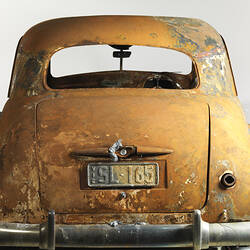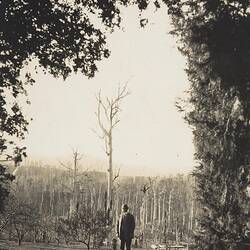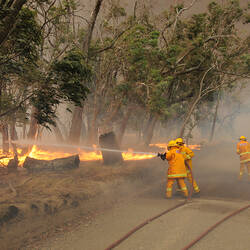Fighting fires is challenging in the Australian landscape. How firefighters react to fire varies greatly between built-up urban environments, rural communities and isolated farmland. Despite these differences, firefighting in country Victoria did not effectively support these challenges until after an extreme fire season in the mid- 1940s. The aftermath of these fires forever changed firefighting with the establishment of a new firefighting body - the Country Fire Authority (CFA).
Pre-1945 Firefighting Practices
Prior to the establishment of the CFA there had been many variations of organised firefighting across regional Victoria. Motivated by prospects during the gold rush, townships including Ballarat developed volunteer fire brigades to respond to fires caused by misplaced candles, oil lamps and lightning strikes. Firefighters would respond to alarm bells across the camps using horse-drawn carriages and water carts.
The 1890's saw the establishment of the Country Fire Brigade Board which had jurisdiction over serval hundred fire brigades. These brigades, however, were predominantly in larger townships and regional cities. Other regional brigades were arranged by local communities and received little to no funding, training or guidance.
The Forests Commission Victoria (FCV) campaigned for the formation of rural fire-fighting units following a bad bushfire season in 1926. As a result, by 1937 there were 320 brigades established across the state. Crucially, they gained the authority to trespass on private property where necessary. Despite these developments, mobilisation of fire brigades and communication between regions proved challenging.
Urgent Need for Change
The summer of 1943 saw a terrible fire season with temperatures and wind speeds more severe than in previous years. By December, large fires had spread across an expanse of regional Victoria impacting a number of South Gippsland communities. Across the state, 51 people were killed, 700 injured, and 650 buildings were destroyed between the December to February fire season. A memorial was constructed at the Hazelwood cemetery to memorialise those who lost their lives.
In addition to the severe fire conditions, many volunteers who would have normally assisted in fighting the blaze had been shipped abroad due to the ongoing World War II. Ongoing water restrictions further complicated the firefighting efforts.
The Establishment of the Country Fire Authority
A Royal Commission into the Yallourn fires of 1944 identified the necessity to form a cohesive regional firefighting network. Following a nearly six-month long debate in State Parliament, legislation to establish the CFA was finally passed. On 2nd April 1945, the Country Fire Authority Act came into force, and the previous fire brigade entities ceased to exist.
Its key missions were to:
-
Strengthen firefighting capabilities in rural areas, ensuring that communities outside the Melbourne Metropolitan Fire Brigade area had adequate and efficient firefighting resources.
-
Bring together various firefighting entities across Victoria, fostering better coordination and collaboration in combating fires.
-
Create a centralised firefighting authority, the CFA aimed to establish a more cohesive and organized firefighting system across the state of Victoria.
-
Enhance fire management strategies and preventative measures, working towards minimizing the occurrence and impact of wildfires and other fire-related emergencies.
The CFA's Legacy and Ongoing Role
Since its establishment, the CFA has been critical in managing and recovering from natural disaster in Victoria. In addition to fighting bushfires, the CFA have been involved in other recovery and relief efforts including other disasters like flooding.
Today, the CFA has over 52,000 volunteers, including firefighters, community educators and support personnel spread across 1211 brigades, 21 districts and 5 regions in Victoria.
References
Country Fire Association 2023, About Us, www.cfa.vic.gov.au.
State Library of Victoria.(1944) Report of the Royal Commission to Inquire into the Place of Origin and the Causes of the Fires which Commenced at Yallourn on the 14th day of February 1944. Available at: https://viewer.slv.vic.gov.au/?entity=IE20138948&mode=browse> (Accessed: 1 November 2023).
Murray, Robert, 1932- & White, Kate, 1949 August 3-. 1995, State of fire : a history of volunteer fire fighting and the Country Fire Authority in Victoria / by Robert Murray and Kate White. Hargreen Publishing Fitzroy, Vic.
1944 'Water Restrictions', Woodend Star and Macedon Advocate (Vic. : 1942 - 1955), 16 September, p. 3. , viewed 01 Nov 2023, http://nla.gov.au/nla.news-article270445533
More Information
-
Keywords
-
Localities
-
Authors
-
Article types




